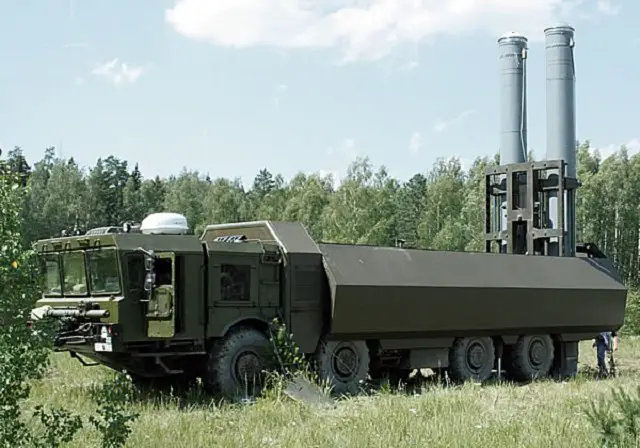Breaking news
Russia to deploy Bastion-P ASM system to Kuril islands Tass 50908163.
| 2016
|
|
|||
|
Defence & Security News - Russia
|
|||
|
|
|||
| Russia to deploy Bastion-P ASM system to Kuril islands | |||
|
The Russian Navy will deploy the Bastion-P (NATO reporting name: SS-C-5 Stooge) mobile coastal defense missile system (MCDMS) to the Kuril Islands in late Summer 2016, according to a source in the Russian defense industry.
|
|||
|
|
|||
 Bastion-P (NATO reporting name: SS-C-5 Stooge) mobile coastal defense missile system (MCDMS) |
|||
|
|
|||
|
"The Ministry of Defense (MoD) is planning to deploy the Bastion-P mobile missile systems to the Kurils in August 2016. The systems will significantly increase the combat capabilities of the Pacific Fleet of the Russian Navy," the source said.
The 3K55 Bastion-P MCDMS is designed to destroy enemy`s naval surface combatants at distances of up to 300 km. K340P, K342R and K380R mobile command post (MCP) vehicles are based on the MZKT-7930 chassis manufactured by the Minsk Wheel Tractor Plant (Russian acronym: MZKT). Both K340P and K342R are equipped with two Onyx 3M55 supersonic cruise missiles (SS-N-26 Strobile/Yakhont) each. The MoD phased in the Bastion-P MCDMS in 2010. Three battalions of Bastion-P systems were issued to the 11th Independent Missile and Artillery Brigade (Black Sea Fleet) near Anapa. Each battalion includes four SPLs, four TLs, one MCP and several technical support systems. The unit can be complemented by target designation vehicle equipped with the Monolith-B radar. Following Crimea's integration into Russia, one Bastion-P battalion of the 11th brigade was transferred to the vicinity of Sebastopol. On September 9, 2014 it participated in drills, firing at several sea targets located at 90 km (56 miles) range. According to Russian Ministry of Defense (MoD), all targets were destroyed. Previously, Russia`s Defense Minister, Sergei Shoigu said that the MoD would deploy coastal defense missile systems and new-generation unmanned aerial vehicles (UAVs) to the Kuril Islands this year. "The scheduled rearmament of units on the Kuril Islands is being held. This year, Russia will deploy Bal and Bastion MCDMSs, as well as new-generation Eleron-3 UAVs there," he pointed out at a meeting of the Defense Ministry’s board. Russia`s Coastal Missile and Artillery Troops (RCMAT) service has deployed 36 modern mobile coastal defense systems, according to the International Institute for Strategic Studies` (IISS) report. As of March 2016, the RCMAT service has received 24 mobile launchers of 3K60 Bal (SS-C-6 Sennight) system. Bal is based on MZKT-7930 8x8 wheeled chassis produced by Minsk Wheel Tractor Plant 'Volat' (Russian acronym: MZKT). The system includes up to two command and control posts, up to four transport-loader vehicles and up to eight self-propelled launchers. Each launcher is armed with eight Kh-35/Kh-35U (AS-20 Kayak) anti-ship missiles (ASM). Kh-35 has a maximum firing range of 120 km, Kh-35U - 260 km. 3K60 Bal system has an ammunition load of up to 64 ASM. Russian KBM company (a subsidiary of the Hugh-Precision Weapons holding) has developed export modification of Bal designated as Bal-E. As of April 2016, there are no officially confirmed foreign operators of Bal-E. The RCMAT service has deployed 12 K340P mobile launchers of 3K55 Bastion (SSC-5 Stooge) system. Bastion comprises four K340P launchers, up to two command and control posts, four K342P transport-loader vehicles and one launch-associated support vehicle. Each K340P mobile launcher is armed with two 3M55 Onyx (SS-N-26 Strobile, export designation: Yakhont) ASM. Bastion has an effective firing range of 300 km. RCMAT service has also deployed several ageing mobile coastal defense systems, namely, 4K44 Redut (SS-C-1 Sepal) and 4K51 Rubezh (SS-C-3 Styx). The Bastion export version has been delivered to Syria and Vietnam. The Bastion-P radar signature has been reduced by 15 to 20 times, owing to the usage of composite materials (CM) in the related operational and support systems, a representative of the Belorussian OKB TSP Research and Production Association said. The canisters of K-340P self-propelled launcher (SPL) and the K342R transporter-loader (TL) are made of multi-layer composite material panels shaped to ensure the absorption of radar signals in several essential segments of electro-magnetic spectrum. The maximum absorption of radar signals is attained primarily in those spectral bands in which space- and air-based radio and electronic reconnaissance systems operate. As a result, the SPL`s and TL`s radar signatures has been reduced by 15 to 20 times. "This significantly reduces the probability of being detected by enemy" the official added. |
|||
|
|
|||
|
© Copyright 2016 TASS. All rights reserved. This material may not be published, broadcast, rewritten or redistributed.
|
|||



















